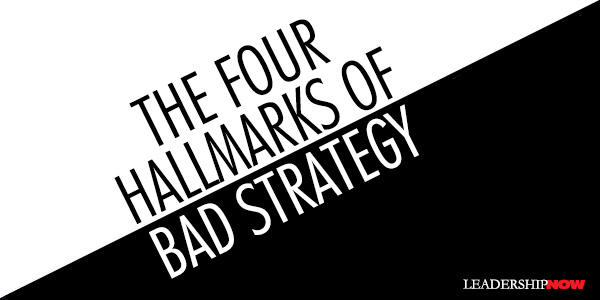 |
 |
09.21.11

The Four Hallmarks of Bad Strategy
STRATEGY expert and author of Good Strategy, Bad Strategy, Richard Rumelt says that bad strategy “grows out of specific misconceptions and leadership dysfunctions.” In short, it is goals and not action. “It assumes that goals are all you need. It puts forward strategic objectives that are incoherent and, sometimes, totally impracticable. It uses high-sounding words and phrases to hide these failings.” To detect a bad strategy, Rumelt suggests looking for one or more of its major hallmarks: Fluff. Fluff is a form of gibberish masquerading as strategic concepts or arguments. It uses “Sunday” words (words that are inflated and unnecessarily abstruse) and apparently esoteric concepts to create the illusion of high-level thinking. Make it simple. Failure to face the challenge. Bad strategy fails to recognize or define the challenge. When you cannot define the challenge, you cannot evaluate a strategy or improve it. If you fail to identify and analyze the obstacles, you don’t have a strategy. Instead, you have either a stretch goal, a budget, or a list of things you wish would happen. Mistaking goals for strategy. Many bad strategies are just statements of desire rather than plans for overcoming obstacles. Bad strategy is long on goals and short on policy or action. Strategic objectives should address a specific process or accomplishment, such as halving the time it takes to respond to a customer or getting work from several Fortune 500 corporations. An excerpt from Rumelt’s response to a client that had a “strategy” that was long on goals and short on actions, is instructive: If you continue down the road you are on you will be counting on motivation to move the company forward. I cannot honestly recommend that as a way forward because competition is not just a battle of wills; it is also a competition over insights and competencies. My judgment is that motivation, by itself, will not give this company enough of an edge to achieve your goals. He explained that “when a company makes the kind of jump in performance your plan envisions, there is usually a key strength you are building on or a change in the industry that opens up new opportunities.” Bad strategic objectives. A strategic objective is set by a leader as a means to an end. Strategic objectives are “bad” when they fail to address critical issues or when they are impracticable. The purpose of good strategy is to offer a potentially achievable way of surmounting a key challenge. If the leader’s strategic objectives are just as difficult to accomplish as the original challenge, there has been little value added by the strategy. 
Posted by Michael McKinney at 01:52 PM
|
BUILD YOUR KNOWLEDGE


How to Do Your Start-Up Right STRAIGHT TALK FOR START-UPS 
Grow Your Leadership Skills NEW AND UPCOMING LEADERSHIP BOOKS 
Leadership Minute BITE-SIZE CONCEPTS YOU CAN CHEW ON 
Classic Leadership Books BOOKS TO READ BEFORE YOU LEAD |